Hyundai Palisade: Timing System / Timing Chain Cover
Repair procedures
| • |
Be careful not to damage the parts located under the vehicle
(floor under cover, fuel filter, fuel tank and canister) when
raising the vehicle using the lift.
(Refer to General Information - "Lift and Support Points")
|
|
| • |
When removing the high pressure fuel pump, high pressure fuel
pipe, delivery pipe, and injector, there is possible risk of
injury from leakage of high pressure fuel. Therefore, do not
attempt repairing immediately after the engine stops.
|
|
| • |
Use fender covers to avoid damaging painted surfaces.
|
| • |
To avoid damage, unplug the wiring connectors carefully while
holding the connector portion.
|
|
| • |
Mark all wiring and hoses to avoid misconnection.
|
|
| 1. |
Remove the engine cover.
(Refer to Engine And Transaxle Assembly - "Engine Cover")
|
| 2. |
Remove the engine room under cover.
(Refer to Engine And Transaxle Assembly - "Engine Room Under Cover")
|
| 3. |
Drain the engine coolant.
(Refer to Cooling System - "Coolant")
|
| 4. |
Drain the engine oil.
(Refer to Lubrication System - "Engine Oil")
|
| 5. |
Remove the air cleaner assembly.
(Refer to Intake And Exhaust System - "Air Cleaner")
|
| 6. |
Disconnect the variable force solenoid (VFS) valve connector (A) and
ground cable (B).

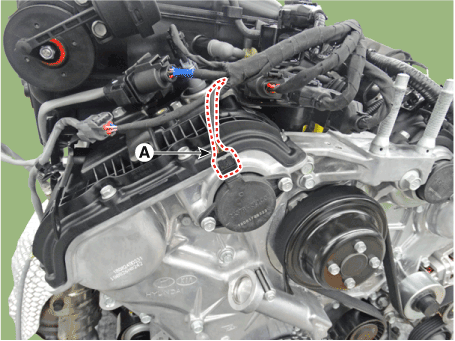
|
| 7. |
Remove the surge tank.
(Refer to Intake And Exhaust System - "Surge Tank")
|
| 8. |
Remove the LH / RH cylinder head cover.
(Refer to Cylinder Head Assembly - "Cylinder Head Cover")
|
| 9. |
Remove the drive belt.
(Refer to Timing System - "Drive Belt")
|
| 10. |
Remove the idler.
(Refer to Timing System - "Idler")
|
| 11. |
Remove the drive belt tensioner.
(Refer to Timing System - "Drive Belt Tensioner")
|
| 12. |
Remove the crankshaft damper pulley.
(Refer to Timing System - "Crankshaft Damper Pulley")
|
| 13. |
Remove the water pump.
(Refer to Cooling System - "Water Pump")
|
| 14. |
Remove the lower oil pan.
(Refer to Lubrication System - "Oil Pan")
|
| 15. |
Remove the RH and LH variable force solenoid (VFS) valve (A).
[RH]
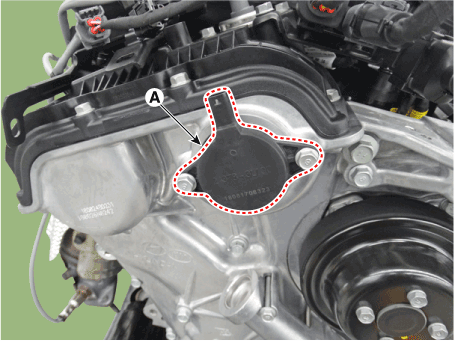
[LH]
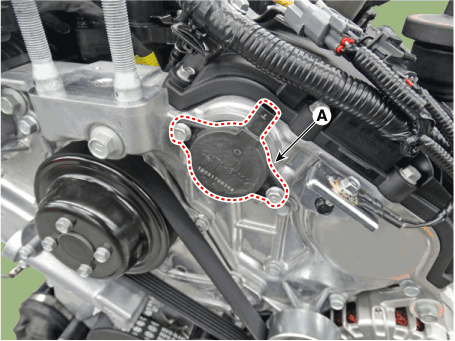
| •
|
The variable force solenoid (VFS) must be removed before
removing the timing chain cover.
|
|
|
| 16. |
Remove the engine mounting support bracket.
| (1) |
Install the jack to the edge of the upper oil pan to support
the engine.
|
• |
Insert a rubber block between jack and upper
oil pan.
|
|
|
| (2) |
Disconnect the engine ground cable (A).
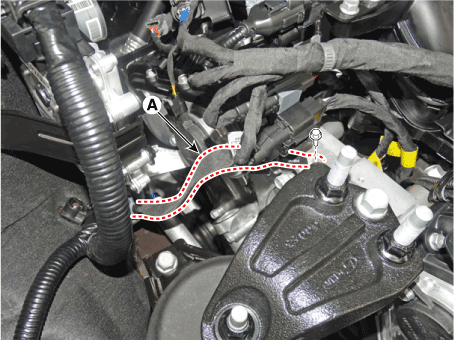
|
| (3) |
Remove the engine mounting support bracket (A).
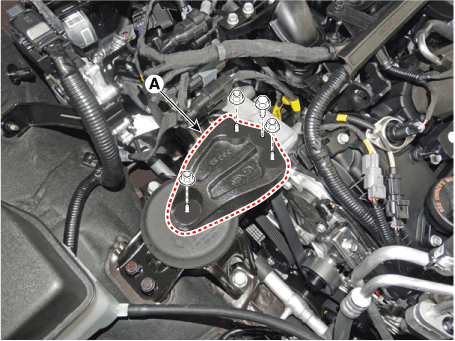
|
|
| 17. |
Remove the timing chain cover (A).
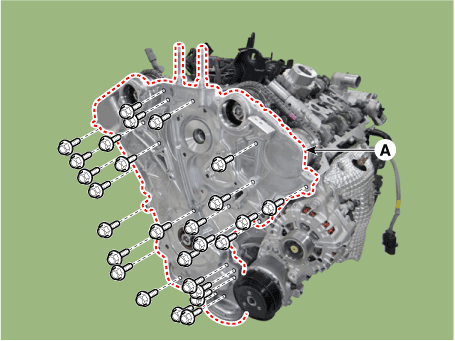
| •
|
Be careful not to damage the contact surfaces of cylinder
block, cylinder head and timing chain cover.
|
|
|
| 1. |
Install the timing chain cover.
| (1) |
The sealant locations on chain cover and on counter parts (cylinder
head, cylinder block, and lower oil pan) must be free of engine
oil and etc.
|
| (2) |
Before assembling the timing chain cover, apply the liquid sealant
TB 1217H on the gap between cylinder head and cylinder block.
Assemble the part within 5 minutes of applying sealant.
|
Bead width : 4.0 mm (0.2 in.)
|
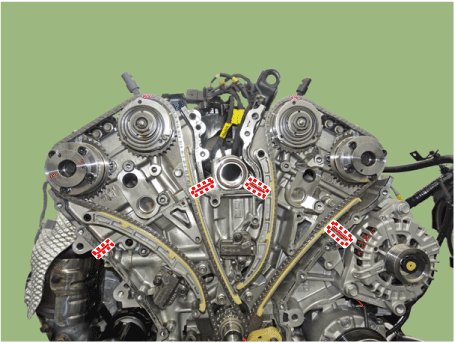
|
| (3) |
Apply liquid sealant TB 1217H on timing chain cover. Assemble
the part within 5 minutes of applying sealant.
Apply sealant in a continuous thread.
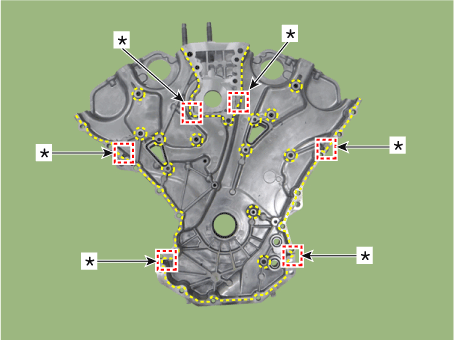
|
• |
Fill six (6) T-joint areas with sealant.
|
|
• |
Apply sealant all around two (2) dowel pin holes.
|
|
|
| (4) |
Install the new gasket (A) to the timing chain cover.
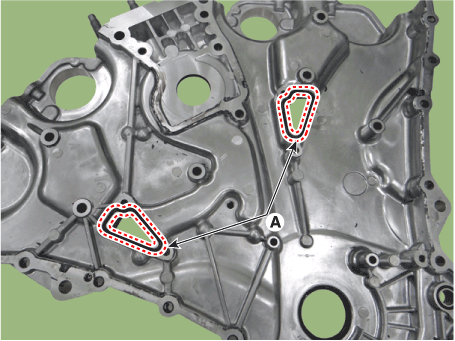
|
• |
During timing chain cover installation, be careful
not to peel off the sealant applied on the timing
cover from contact with other parts.
|
|
|
| (5) |
Install the new O-ring (A).
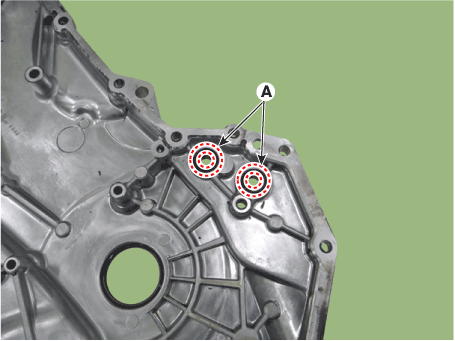
|
| (6) |
The dowel pins on the cylinder block and holes on the timing
chain cover (A) should be used as a reference for assembling
the timing chain cover to the exact position.
|
Tightening torque
A (21 pcs) :
18.6 - 21.6 N.m (1.9 - 2.2 kgf.m, 13.7 - 15.9 lb.ft)
B (2 pcs) :
24.5 - 26.5 N.m (2.5 - 2.7 kgf.m, 18.1 - 19.5 lb.ft)
C (2 pcs) :
58.8 - 68.8 N.m (6.0 - 7.0 kgf.m, 43.4 - 50.6 lb.ft)
D (3 pcs) :
9.8 - 11.8 N.m (1.0 - 1.2 kgf.m, 7.2 - 8.7 lb.ft)
|
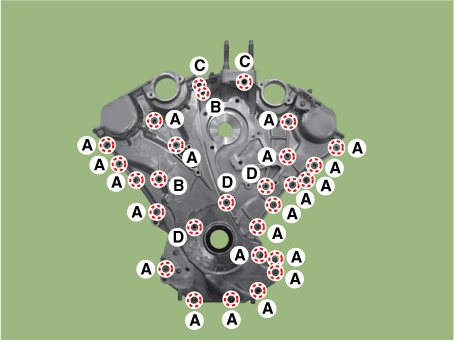
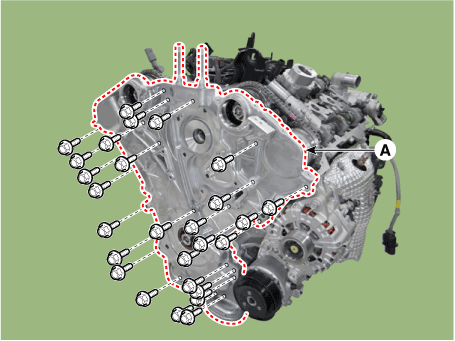
|
| (7) |
Do not run the engine or perform pressure test within 30 minutes
of assembly.
|
|
| 2. |
Install the engine mounting support bracket.
| (1) |
Install the engine mounting support bracket (A).
|
Tightening torque :
98.1 - 117.7 N.m (10.0 - 12.0 kgf.m, 72.3 - 86.8 lb-ft)
|
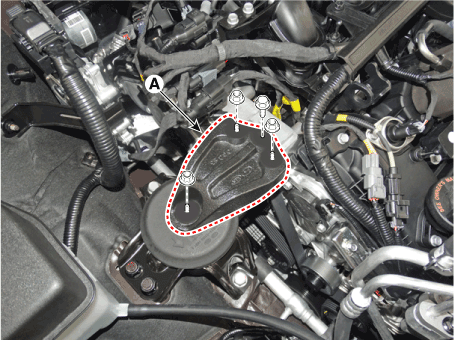
|
| (2) |
Connect the engine ground cable (A).
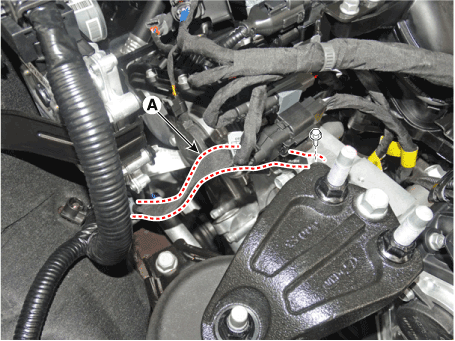
|
| (3) |
Remove the jack from the upper oil pan.
|
|
| 3. |
Install the RH and LH variable force solenoid (VFS) valve (A).
|
Tightening torque :
9.8 - 11.8 N.m (1.0 - 1.2 kgf.m, 7.2 - 8.7 lb.ft)
|
[RH]
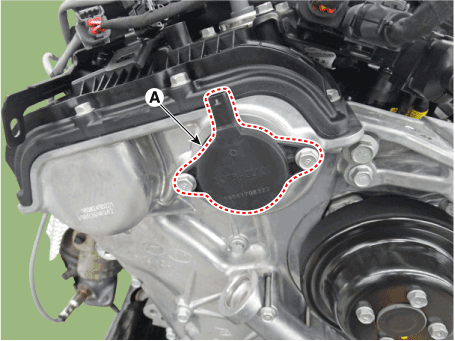
[LH]
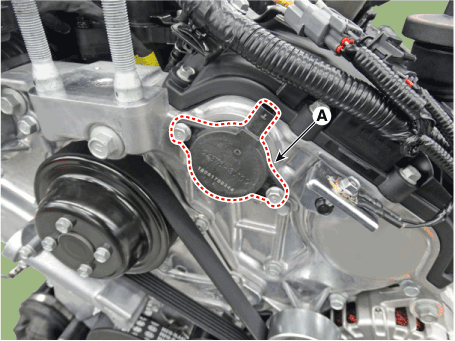
| •
|
Do not use any dropped variable force solenoid (VFS)
valve.
|
| •
|
Note below cautions when installing variable force solenoid
(VFS) valve.
|
| 1) |
After replacing the O-ring (A) of variable force solenoid
(VFS) valve, apply engine oil on new O-ring (A).
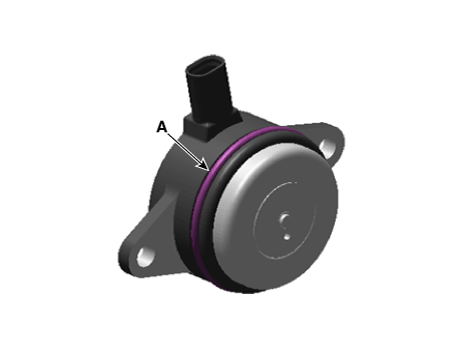
|
| 2) |
Push variable force solenoid (VFS) valve up to the timing
chain cover, and temporarily tighten the bolt.
|
| 3) |
Tighten the variable force solenoid (VFS) valve to the
specified torque.
|
|
|
| 4. |
Install the remaining parts in the reverse order of removal.
| •
|
Clean the battery posts and cable terminals with sandpaper.
Assemble and then apply grease to prevent corrosion.
|
| •
|
Inspect for fuel leakage.
|
| –
|
After assembling the fuel line, turn on the ignition
switch (without operating the starter) so that the fuel
pump runs for approximately two seconds and fuel line
pressurizes.
|
| –
|
Repeat this operation two to three times, and then check
for fuel leakage at any point on the fuel lines.
|
| •
|
Refill radiator and reservoir tank with engine coolant.
|
| •
|
Bleed air from the cooling system.
|
| –
|
Start engine and let it run until it warms up (until
the radiator fan operates 3 or 4 times).
|
| –
|
Turn off the engine and let it cool down. Check the
level in the radiator, and add coolant if needed. This
will allow trapped air to be released from the cooling
system.
|
| –
|
Put radiator cap on tightly, then run the engine again
and check for leaks.
|
|
|
Repair procedures
Removal
•
Be careful not to damage the parts located under the vehicle
(floor under cover, fuel filter, fuel tank and canister) when
raising the vehicle using the lift...
Repair procedures
Removal
•
Be careful not to damage the parts located under the vehicle
(floor under cover, fuel filter, fuel tank and canister) when
raising the vehicle using the lift...
Other information:
The remote key will not work if any of
the following occur:
The key is in the ignition switch.
You exceed the operating distance
limit (about 90 feet [30 m]).
The remote key battery is weak.
Other vehicles or objects may be
blocking the signal...
Repair procedures
Replacement
1.
Remove the front door trim.
(Refer to Front Door - "Front Door Trim")
2.
Loosen the mounting screws and remove the front door inside handle (A)...
Categories
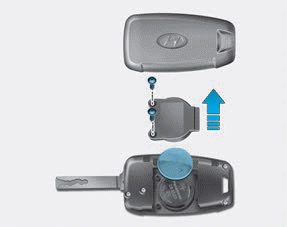
If the remote key is not working properly,
try replacing the battery with a
new one.
Battery Type: CR2032
To replace the battery:
read more
 Front Oil Seal
Front Oil Seal Timing Chain
Timing Chain





























